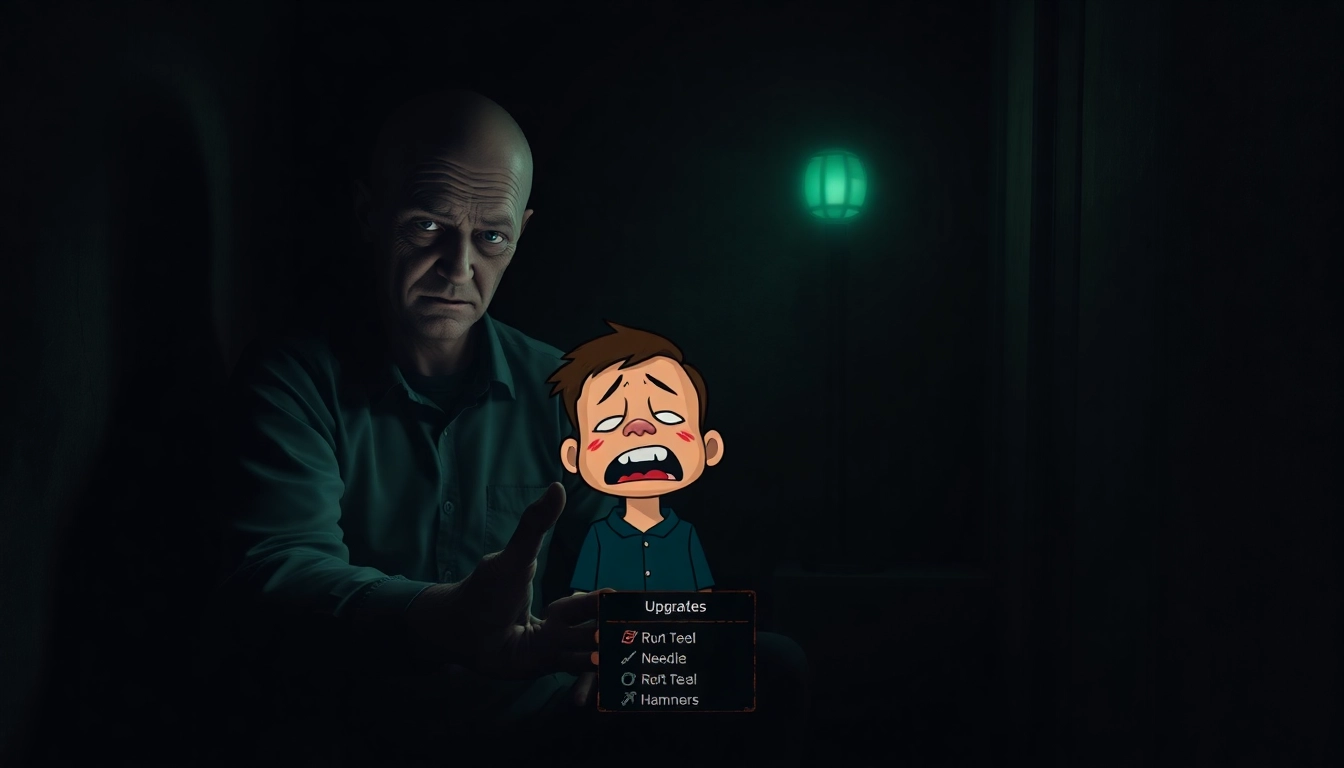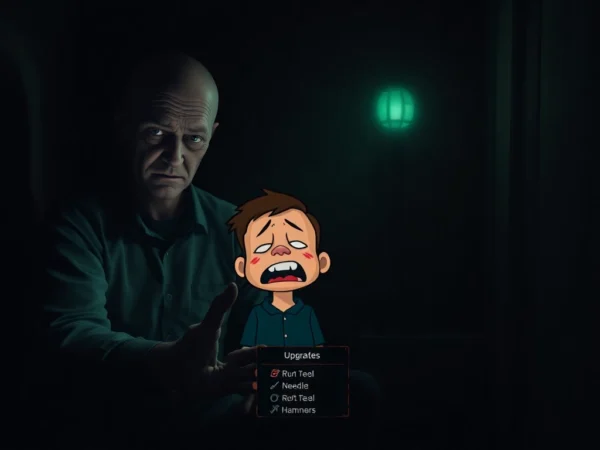Blood Money: The Psychological Horror of Morality and Survival in a Dark Clicker Game
Overview and Context of BloodMoney: A Psychological Horror Clicker Experience
In the realm of indie horror games, few titles manage to plunge players into such a deeply unsettling psychological journey as blood money. This dark clicker game challenges players to confront their moral boundaries through a disturbing narrative intertwined with addictive gameplay mechanics. The game’s core premise revolves around a desperate struggle for survival, where each click not only generates income but also chips away at the moral integrity of the protagonist. As players navigate the twisted world of BloodMoney, they are forced to decide how far they are willing to go to secure their future, making it a profound exploration of morality, desperation, and human nature.
The Dark Narrative of BloodMoney and the Character of Harvey
At the heart of BloodMoney lies the story of a character diagnosed with a severe medical condition, facing an urgent need for $25,000 to cover life-saving treatment. With time running out and options dwindling, a strange figure named Harvey enters the scene, offering an unsettling solution: click on him to earn money. Harvey appears cheerful and innocent at first, embodying a seemingly harmless helper in a dire situation. However, as players progress, the narrative darkens, revealing Harvey’s suffering and the sinister mechanics behind the game.
This game’s narrative masterfully explores themes of morality, sacrifice, and the corrupting influence of desperation. Harvey’s cheerful demeanor gradually fades as his pain increases with each click, visually and emotionally immersing players in his suffering. The story raises uncomfortable questions: How much are we willing to sacrifice morally for survival? Does the end justify the means? These questions resonate deeply within the game’s dark, immersive universe, making players reflect on their own values and choices.
Core Gameplay Mechanics: Clicking, Upgrades, and Multiple Pathways
Clicking Mechanics and Earning Money
The gameplay in BloodMoney revolves around a simple yet profoundly impactful mechanic: clicking on Harvey to generate income. Each click produces a fixed amount of cash, initially seeming harmless and even humorous. However, the game quickly reveals its darker layers as the visual and emotional toll on Harvey escalates. The more you click, the more Harvey suffers, with his appearance and reactions subtly changing to reflect his increasing pain and fear.
Upgrade System and Tools of Descent
Players can purchase upgrades from the in-game shop to maximize their earnings. These upgrades include a variety of tools—ranging from needles to hammers—that intensify Harvey’s suffering but significantly boost the money gained per click. Each purchase introduces a new layer of moral complexity, as the game visually and psychologically demonstrates the cost of these choices. The upgrade system creates a risk-reward dynamic: do you opt for the most profitable yet most damaging tools, or do you try to minimize Harvey’s pain?
Multiple Pathways and Endings
BloodMoney offers multiple pathways through its narrative, leading to three distinct endings: the Good Ending, the Normal Ending, and the Bad Ending. These are determined by the player’s choices throughout the game—particularly how much harm they inflict on Harvey and how they approach the moral dilemma. The game subtly tracks your decisions, influencing not only the final outcome but also Harvey’s visual state and dialogue, making each playthrough a personalized journey into morality.
The Psychological Horror: Time Pressure and Moral Decay
One of the most compelling aspects of BloodMoney is its ability to evoke psychological horror. The ticking clock to reach $25,000 creates intense time pressure, heightening the player’s sense of desperation. As the game progresses, the visuals become increasingly disturbing—Harvey’s suffering intensifies, and the environment takes on a darker tone. The game’s design cleverly manipulates psychological cues, such as Harvey’s changing expressions and dialogue, to evoke feelings of guilt, helplessness, and moral conflict.
This pressure and visual decay serve to mirror the protagonist’s spiraling moral decay. The game does not shy away from depicting violent tools—like hammers or needles—that are used to increase earnings rapidly but at the cost of Harvey’s well-being. These choices force players to confront their own boundaries, questioning whether survival justifies cruelty and whether morality can be compromised for self-interest.
The Desperate Situation and Harvey’s Proposition
As players approach their financial goal, Harvey’s situation becomes more desperate. His cheerful facade fades entirely, revealing a character trapped in agony, yet still offering a glimmer of hope. Harvey’s proposition to click for money becomes a moral crossroads: do you continue to maximize profit at all costs, or do you try to minimize his suffering? This decision is central to the game’s philosophical exploration, emphasizing that every choice has consequences—visible and invisible.
The game’s narrative culminates in a moment of truth where players must decide how they have navigated Harvey’s suffering—either choosing the path of minimal harm, moderate violence, or maximum efficiency regardless of the human toll. These choices ultimately determine which of the three endings unfolds, each providing a different perspective on morality and survival.
Visual and Psychological Design: Creating an Unsettling Atmosphere
BloodMoney excels in its atmospheric and visual design, crafting a deeply unsettling environment that evolves with the player’s choices. From bright, cheerful initial visuals to increasingly disturbing imagery, the game visually mirrors the moral descent of the player. Harvey’s appearance changes—from a happy, naive figure to a suffering, fear-stricken individual—subtly reinforcing the emotional weight of each decision.
The dialogue and sound design further enhance this atmosphere, with subtle cues that evoke discomfort, guilt, and empathy. The game’s use of visual cues—such as Harvey’s trembling hands or widened eyes—creates a visceral experience that makes players question their own morality. The psychological horror is heightened by the game’s ability to evoke empathy for Harvey, even as players are compelled to choose violent options for financial gain.
The Evolution of Harvey: Emotional and Visual Changes
One of the most compelling features of BloodMoney is the visual and emotional transformation of Harvey. At the start, he appears cheerful and naive, embodying innocence and a desire to help. As the game progresses, his face becomes more gaunt, his eyes more fearful, and his reactions more distressed. These changes reflect the cumulative pain inflicted by the player’s choices, providing a visceral indicator of moral compromise.
Players have observed that Harvey’s reactions to tools like the needle or hammer are genuine, making their moral implications even more impactful. Interestingly, some players noted that Harvey seems genuinely surprised by the more violent tools, suggesting that he might not fully understand what the shop offers. This raises intriguing questions about agency, innocence, and culpability within the game’s narrative universe.
Player Experience: Confronting Morality and Desperation
Playing BloodMoney is an emotionally intense experience. The game’s design ensures that players are constantly confronted with difficult moral dilemmas, forcing them to reflect on their own values. The visceral reactions—such as feeling guilty when Harvey reacts to pain—are so effectively rendered that many players experience genuine emotional discomfort, despite knowing it’s a game.
There is a paradox at the heart of BloodMoney: it’s addictive gameplay paired with morally challenging content. The urge to reach the financial goal conflicts with the emotional toll of causing Harvey suffering, creating a compelling psychological tension. Ultimately, players must decide whether they prioritize survival or morality, with the game’s multiple endings providing varied reflections on these choices.
Community Insights and Reactions
Within the gaming community, BloodMoney has garnered attention for its unsettling themes and innovative approach to psychological horror. Many players share their experiences, noting how the game’s subtle cues and emotional design make it more impactful than traditional horror titles. Videos and discussions highlight how Harvey’s reactions and visual cues deepen the moral complexity, leading to intense debates about ethics and human nature.
Players often discuss their strategies—whether they aimed for the Good, Normal, or Bad Endings—and how their choices affected Harvey’s state. Some have even discovered that it’s possible to reach the Good Ending with certain tools, like the hammer, by carefully balancing harm and earnings. The community’s insights reveal a shared fascination with the game’s capacity to evoke empathy and moral reflection.
The Deeper Message: Humanity’s Duality and Ethical Boundaries
BloodMoney is more than just a dark clicker game; it is an allegory for human duality—the struggle between good and evil within us all. Harvey symbolizes innocence and the desire to help, while the shop and the tools represent darker impulses and societal pressures to prioritize profit over morality.
The game asks profound questions: Are we inherently good or evil? Is survival worth sacrificing our morals? Through its design, BloodMoney suggests that in desperate circumstances, many people might cross moral boundaries they would normally never consider. The game’s multiple endings serve as moral reflections—either condemning, accepting, or exploring the complexities of human nature when pushed to the brink.
Conclusion: Reflecting on the Dark Descent of BloodMoney
BloodMoney stands as a powerful testament to the potential of indie game design to explore complex moral themes through innovative mechanics and atmospheric storytelling. Its blend of psychological horror, moral dilemma, and addictive gameplay creates a haunting experience that leaves a lasting impression. The game challenges players to consider how far they are willing to go when faced with life-and-death stakes, raising questions that extend beyond the screen into real-world ethical considerations.
Ultimately, BloodMoney is a dark mirror reflecting the human condition—our capacity for both kindness and cruelty, depending on circumstances. The choices you make in the game shape Harvey’s fate and reveal your own moral boundaries. Will you choose the path of compassion, or will you prioritize profit at any cost? The game’s ending depends on your decisions, serving as a stark reminder of the thin line between morality and depravity.
For those interested in exploring the depths of human morality through a visceral, unsettling experience, BloodMoney offers a compelling journey. Dive into this dark world and confront your own conscience—because in BloodMoney, every click counts.
Learn more about this disturbing psychological journey by visiting blood money. Are you ready to face the moral consequences? The descent begins now.


